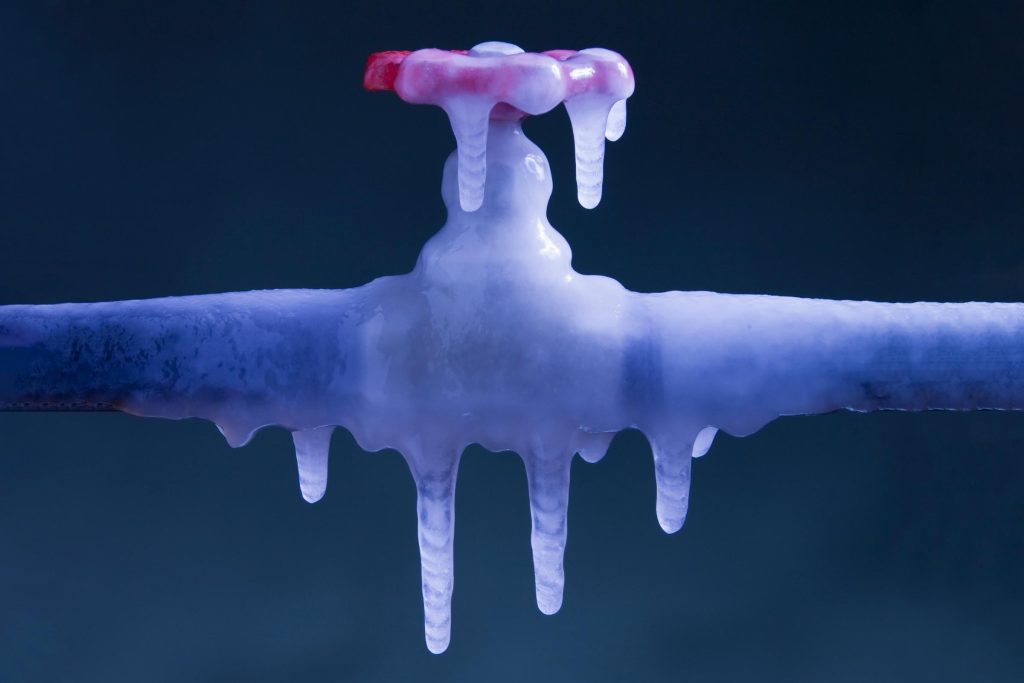Getting Hose Bibbs Ready for Winter

I’m sure all of us in the DFW area remember last year’s crazy freeze–and I can safely say that every one of us wants to avoid any more burst pipes in case we get another weather event and putting away the garden hose and storing it until spring should be a top priority. If you experienced, then or previous, a burst pipe, then you know how dire it is to turn off your outdoor water supply lines correctly. If you don’t adhere to the correct procedure in turning off your outdoor hose bibbs, water can be left in the supply line, which can freeze, expand, and split your pipes. Winterizing your outdoor faucets before it’s too late can prevent you from having to deal with the frustrations and damage resulting from frozen or burst pipes.
Winterize your hose bibs before temperatures drop to 20 degrees.
Pipes located outdoors are subject to freezing once outdoor temperatures fall below 20 degrees. A frozen pipe can lead to a burst pipe, and a burst pipe means costly repairs and potential structural damage. Prevention is the key to avoiding burst pipes during the winter. Hose bibs, or faucets, are an outdoor plumbing fixture found on most houses. Winterizing your home’s hose bibs is an annual maintenance task that should be completed before the freezing temperatures roll in.
STEPS TO WINTERIZE YOUR HOSE BIBBS
Such easy steps can save you a nightmare of problems once temperatures drop. Here are a few simple steps that outline how to drain hose bibbs for winter and ensure the integrity of your outdoor plumbing:
1) Detach your hoses. Next, you’ll need to detach your hoses from your spigots, making sure to drain them before putting them into storage.
2) Store your hoses indoors. Keeping your hoses in heated garages or basements will protect them from damage caused by freezing temperatures outside and ensure they remain in good condition.
3) Install Outdoor Faucet Covers: The last step to winterizing outdoor faucets is to protect them with insulation. An easy way to do this is to install an outdoor faucet cover on each outdoor fixture, including frost-free spigots. Faucet covers are either square or dome-shaped shells that fit right over outdoor faucets, or they are flexible bags made of thick fabric stuffed with insulation.
Once you’ve completed these simple steps, you can rest assured that your hose bibbs will be in good shape come spring! Winterizing your hose bibbs will save you the hassle and expense of dealing with frozen pipes or busted pipes. Once you learn to winterize your outdoor spigots, it will become second nature to complete this task each year!
INVEST IN FROST-PROOF HOSE BIBBS
For added assurance, you can invest in frost-proof hose bibbs for your home. Frost-free hose bibbs are installed with a slight downward pitch and the shut-off valve is located several inches inside your home. This maintains your tube integrity by preventing water from sitting in the pipes and freezing. If you don’t want to worry about cracking hose bibbs or freezing damage during the winter months, installing frost-proof hose bibbs is the way to go!
How Frost-Proof Hose Bibs Work:
A frost-free outdoor faucet looks very similar to a traditional faucet from the outside, although you should notice a slight downward pitch that allows water to drain out to avoid freezing. A frost-proof hose bib is constructed in such a way that you do not have to shut off the water supply from inside the house to prevent freeze damage in the winter. It contains a valve that opens and closes when you turn the faucet on and off, effectively cutting off the water supply whenever your outdoor faucet is in the “off” position. This prevents water from sitting in the pipe and freezing.
The parts of a freeze-proof outdoor spigot include the handle and spout on the outside that look similar to any other faucet although the spout connects to a longer pipe than a traditional faucet. This longer pipe is typically between 4 and 14 inches long and oftentimes longer, up to 24 inches, in order to reach far enough inside the home where any water inside the pipe will rest at warm temperatures.
- You should still disconnect garden hoses from them prior to the winter months.
- Frost-free spigots should still be insulated, even though they are resistant to freezing, they are not completely frost-proof in the coldest weather. There are rubber gaskets and washers inside the frost-free spigots that will benefit from the extra protection from the cold.
If you need help winterizing your home’s plumbing or you’d like to learn more about frost-proof hose bibb installation, give Schrader Plumbing a call today at 817-262-0989! We’re standing by.
Categories: Burst Pipes, How to's,By: Michelle Kurcina
Last modified:
Last Modified: December 1, 2021 at 5:30 pm


